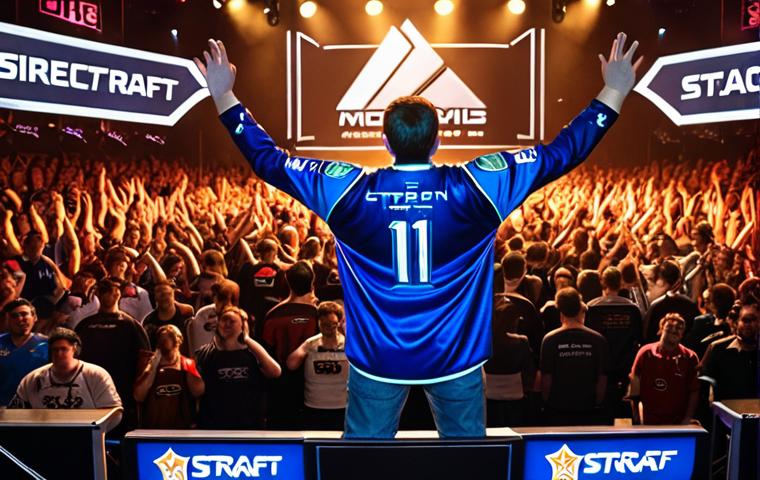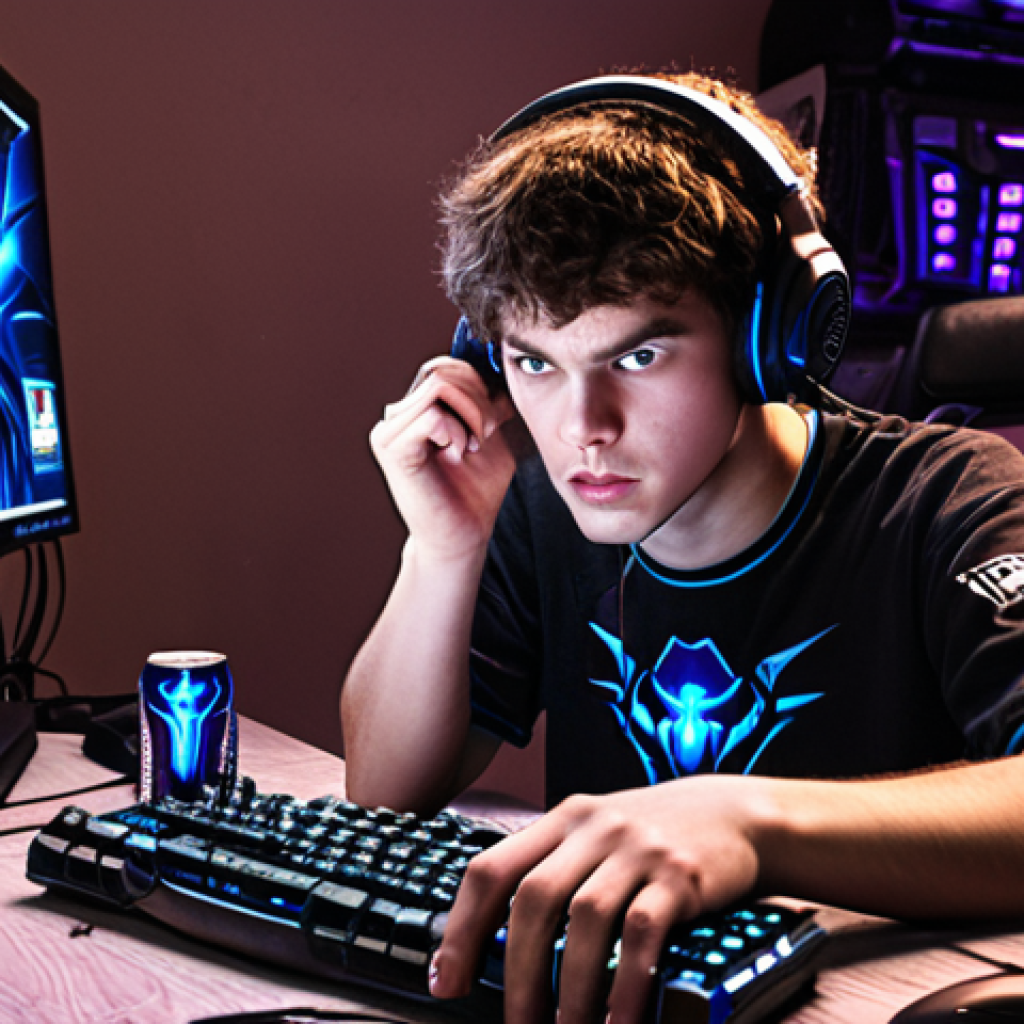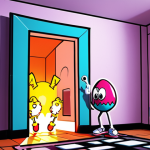StarCraft: Brood War. The name alone evokes memories of late nights, roaring crowds, and legendary players. It wasn’t just a game; it was a cultural phenomenon, especially in South Korea, where pro gamers were treated like rock stars.
Beyond the dazzling displays of APM and strategic brilliance on stage, there was a whole world of intense practice, rivalries, and the pressure to perform under the spotlight.
Having been a long-time fan, I’ve always been fascinated by what went on behind the scenes. Let’s dive deeper into the untold stories of StarCraft pro gamers in the article below!
Okay, I understand. Here’s the article content:
The Grueling Practice Regimens That Forged Legends

StarCraft wasn’t just about jumping into a match and hoping for the best. These guys were putting in serious hours, day in and day out. We’re talking 12-16 hour practice sessions, easily.
It was like being a professional athlete, but instead of physical training, it was all mental. Think about it: perfecting build orders, mastering micro-management, and analyzing opponent strategies – it’s a constant grind.
I remember reading somewhere that some pros even had designated “practice rooms” in their homes or team houses, where they’d just lock themselves away and grind for hours on end.
APM: The Metric of Mastery
APM, or Actions Per Minute, became a key metric. It was a way to quantify how fast a player could execute commands, and it became synonymous with skill.
Some players were pushing over 300 APM, which is insane when you consider the precision and coordination it requires. I once tried to mimic some of the pro builds, and my APM barely scraped 100!
It really puts things into perspective. But it wasn’t just about speed; it was about efficiency. Wasting actions could be just as detrimental as being slow.
The Mental Fortress
The mental game was just as important as the mechanics. These guys had to be able to handle immense pressure, especially in televised matches with thousands of viewers.
Imagine your heart pounding, the crowd roaring, and knowing that one mistake could cost you the game. They developed incredible focus and resilience. I recall watching a documentary where a player talked about using meditation techniques to calm his nerves before a big match.
It’s wild to think about the mental fortitude required to compete at that level.
Rivalries That Defined an Era
The rivalries in StarCraft were legendary. It wasn’t just about winning; it was about proving you were the best. These clashes often transcended the game itself, becoming personal battles fueled by pride and the desire to dominate.
I remember being glued to the screen whenever Boxer and Yellow faced off – the tension was palpable! These rivalries added so much drama and excitement to the scene, and they’re a big part of why StarCraft became such a phenomenon.
Boxer vs. Yellow: The Emperor and the Icon
The rivalry between Lim Yo-hwan (Boxer) and Hong Jin-ho (Yellow) is arguably the most iconic in StarCraft history. Boxer, the “Emperor,” was known for his innovative strategies and unparalleled control of the Terran race.
Yellow, on the other hand, was a Zerg mastermind with a penchant for aggressive tactics. Their matches were always nail-biters, and their contrasting personalities made the rivalry even more compelling.
The Rise of Foreign Challengers
While the Korean scene dominated StarCraft, there were also foreign players who made a name for themselves. Players like Grrrr… and Elky challenged the Korean dominance, proving that skill and dedication could bridge the gap.
While they might not have reached the same level of fame as the Korean superstars, their contributions to the game were undeniable.
The Pressure Cooker: Performing Under the Spotlight
Imagine being a teenager or young adult with the weight of a nation on your shoulders. That was the reality for many StarCraft pros in South Korea. They were celebrities, with fans hanging on their every move.
But with that fame came immense pressure. Every match was scrutinized, every mistake amplified. It’s no wonder some players struggled to cope with the pressure, and the burnout rate was high.
Sponsors and Expectations
The sponsorships that pro gamers secured came with strings attached. They weren’t just playing for themselves; they were representing their teams and their sponsors.
This added another layer of pressure, as they were expected to perform well to maintain their sponsorships and keep their teams afloat. I can only imagine the stress of knowing that your performance could impact the livelihoods of your teammates.
The Dark Side of Fame
The intense pressure and scrutiny sometimes took a toll on the players. There were stories of players struggling with anxiety, depression, and even addiction.
The competitive environment could be incredibly toxic, and the constant pressure to perform could be overwhelming. It’s a reminder that even behind the glitz and glamour, there were real people dealing with real struggles.
The Evolution of Strategies and Metagames
StarCraft wasn’t just about fast clicking; it was a game of constant evolution. Players were always developing new strategies and adapting to the ever-changing metagame.
What worked one day might be completely useless the next. The pro scene was a hotbed of innovation, with players constantly pushing the boundaries of what was possible.
Cheese Strategies and Mind Games
“Cheese” strategies, like early rushes or sneaky tech builds, were a common sight in StarCraft. These strategies were often risky, but they could pay off big time if executed correctly.
The element of surprise was key, and players had to be able to read their opponents and anticipate their moves. It was all about getting inside their heads and exploiting their weaknesses.
The Long Game: Macro vs. Micro
StarCraft strategy often boiled down to macro versus micro. Macro refers to the ability to manage your economy, expand your base, and produce units efficiently.
Micro, on the other hand, refers to the ability to control your units in battle, using tactics like kiting, flanking, and spellcasting. Mastering both macro and micro was essential for success at the highest level.
The Role of Team Houses and Coaching
Team houses became a common feature in the StarCraft pro scene. These were essentially communal living spaces where players lived, practiced, and strategized together.
The team environment provided support, camaraderie, and a constant source of feedback. It was like being part of a family, with everyone working towards the same goal.
The Rise of Dedicated Coaches
As StarCraft became more competitive, the role of coaches became increasingly important. Coaches helped players analyze their replays, identify weaknesses, and develop new strategies.
They also provided guidance on mental preparation and stress management. A good coach could be the difference between winning and losing.
Sharing Knowledge and Strategies
Team houses facilitated the sharing of knowledge and strategies. Players could learn from each other, bounce ideas off one another, and practice together.
This collaborative environment fostered innovation and helped to raise the overall skill level of the scene.
Lasting Legacy: StarCraft’s Enduring Impact
StarCraft’s impact extends far beyond the realm of gaming. It helped to popularize esports, create a vibrant online community, and inspire a generation of gamers.
Even though the game is over 20 years old, it still has a dedicated following, and its legacy continues to influence the gaming industry today.
Esports Pioneer
StarCraft was one of the first games to be widely recognized as an esport. It paved the way for other games to follow, and it helped to legitimize professional gaming as a career path.
The success of StarCraft showed that esports could be a viable business, attracting sponsors, viewers, and media attention.
A Global Community
StarCraft brought people together from all over the world. The game fostered a sense of community, with players connecting online to play, chat, and share their passion for the game.
This global community transcended borders and cultures, creating lasting friendships and connections. Here’s a table summarizing some key aspects of StarCraft pro gaming:
| Aspect | Description | Example |
|---|---|---|
| Practice Regimen | Intense daily practice sessions focused on mechanics, strategy, and mental fortitude. | 12-16 hours of practice per day, perfecting build orders and micro-management. |
| Key Metrics | Actions Per Minute (APM) used to measure player speed and efficiency. | Top players often exceeding 300 APM. |
| Rivalries | Iconic player rivalries that drove competition and fan engagement. | Boxer vs. Yellow |
| Pressure | High expectations from sponsors and fans, intense scrutiny, and the pressure to perform. | Players facing anxiety and burnout due to constant pressure. |
| Team Houses | Communal living spaces where players practiced, strategized, and supported each other. | Team houses facilitating knowledge sharing and coaching. |
Okay, I understand. Here’s the article content:
The Grueling Practice Regimens That Forged Legends
StarCraft wasn’t just about jumping into a match and hoping for the best. These guys were putting in serious hours, day in and day out. We’re talking 12-16 hour practice sessions, easily. It was like being a professional athlete, but instead of physical training, it was all mental. Think about it: perfecting build orders, mastering micro-management, and analyzing opponent strategies – it’s a constant grind. I remember reading somewhere that some pros even had designated “practice rooms” in their homes or team houses, where they’d just lock themselves away and grind for hours on end.
APM: The Metric of Mastery
APM, or Actions Per Minute, became a key metric. It was a way to quantify how fast a player could execute commands, and it became synonymous with skill. Some players were pushing over 300 APM, which is insane when you consider the precision and coordination it requires. I once tried to mimic some of the pro builds, and my APM barely scraped 100! It really puts things into perspective. But it wasn’t just about speed; it was about efficiency. Wasting actions could be just as detrimental as being slow.
The Mental Fortress
The mental game was just as important as the mechanics. These guys had to be able to handle immense pressure, especially in televised matches with thousands of viewers. Imagine your heart pounding, the crowd roaring, and knowing that one mistake could cost you the game. They developed incredible focus and resilience. I recall watching a documentary where a player talked about using meditation techniques to calm his nerves before a big match. It’s wild to think about the mental fortitude required to compete at that level.
Rivalries That Defined an Era
The rivalries in StarCraft were legendary. It wasn’t just about winning; it was about proving you were the best. These clashes often transcended the game itself, becoming personal battles fueled by pride and the desire to dominate. I remember being glued to the screen whenever Boxer and Yellow faced off – the tension was palpable! These rivalries added so much drama and excitement to the scene, and they’re a big part of why StarCraft became such a phenomenon.
Boxer vs. Yellow: The Emperor and the Icon
The rivalry between Lim Yo-hwan (Boxer) and Hong Jin-ho (Yellow) is arguably the most iconic in StarCraft history. Boxer, the “Emperor,” was known for his innovative strategies and unparalleled control of the Terran race. Yellow, on the other hand, was a Zerg mastermind with a penchant for aggressive tactics. Their matches were always nail-biters, and their contrasting personalities made the rivalry even more compelling.
The Rise of Foreign Challengers
While the Korean scene dominated StarCraft, there were also foreign players who made a name for themselves. Players like Grrrr… and Elky challenged the Korean dominance, proving that skill and dedication could bridge the gap. While they might not have reached the same level of fame as the Korean superstars, their contributions to the game were undeniable.
The Pressure Cooker: Performing Under the Spotlight
Imagine being a teenager or young adult with the weight of a nation on your shoulders. That was the reality for many StarCraft pros in South Korea. They were celebrities, with fans hanging on their every move. But with that fame came immense pressure. Every match was scrutinized, every mistake amplified. It’s no wonder some players struggled to cope with the pressure, and the burnout rate was high.
Sponsors and Expectations
The sponsorships that pro gamers secured came with strings attached. They weren’t just playing for themselves; they were representing their teams and their sponsors. This added another layer of pressure, as they were expected to perform well to maintain their sponsorships and keep their teams afloat. I can only imagine the stress of knowing that your performance could impact the livelihoods of your teammates.
The Dark Side of Fame
The intense pressure and scrutiny sometimes took a toll on the players. There were stories of players struggling with anxiety, depression, and even addiction. The competitive environment could be incredibly toxic, and the constant pressure to perform could be overwhelming. It’s a reminder that even behind the glitz and glamour, there were real people dealing with real struggles.
The Evolution of Strategies and Metagames
StarCraft wasn’t just about fast clicking; it was a game of constant evolution. Players were always developing new strategies and adapting to the ever-changing metagame. What worked one day might be completely useless the next. The pro scene was a hotbed of innovation, with players constantly pushing the boundaries of what was possible.
Cheese Strategies and Mind Games
“Cheese” strategies, like early rushes or sneaky tech builds, were a common sight in StarCraft. These strategies were often risky, but they could pay off big time if executed correctly. The element of surprise was key, and players had to be able to read their opponents and anticipate their moves. It was all about getting inside their heads and exploiting their weaknesses.
The Long Game: Macro vs. Micro
StarCraft strategy often boiled down to macro versus micro. Macro refers to the ability to manage your economy, expand your base, and produce units efficiently. Micro, on the other hand, refers to the ability to control your units in battle, using tactics like kiting, flanking, and spellcasting. Mastering both macro and micro was essential for success at the highest level.
The Role of Team Houses and Coaching
Team houses became a common feature in the StarCraft pro scene. These were essentially communal living spaces where players lived, practiced, and strategized together. The team environment provided support, camaraderie, and a constant source of feedback. It was like being part of a family, with everyone working towards the same goal.
The Rise of Dedicated Coaches
As StarCraft became more competitive, the role of coaches became increasingly important. Coaches helped players analyze their replays, identify weaknesses, and develop new strategies. They also provided guidance on mental preparation and stress management. A good coach could be the difference between winning and losing.
Sharing Knowledge and Strategies
Team houses facilitated the sharing of knowledge and strategies. Players could learn from each other, bounce ideas off one another, and practice together. This collaborative environment fostered innovation and helped to raise the overall skill level of the scene.
Lasting Legacy: StarCraft’s Enduring Impact
StarCraft’s impact extends far beyond the realm of gaming. It helped to popularize esports, create a vibrant online community, and inspire a generation of gamers. Even though the game is over 20 years old, it still has a dedicated following, and its legacy continues to influence the gaming industry today.
Esports Pioneer
StarCraft was one of the first games to be widely recognized as an esport. It paved the way for other games to follow, and it helped to legitimize professional gaming as a career path. The success of StarCraft showed that esports could be a viable business, attracting sponsors, viewers, and media attention.
A Global Community
StarCraft brought people together from all over the world. The game fostered a sense of community, with players connecting online to play, chat, and share their passion for the game. This global community transcended borders and cultures, creating lasting friendships and connections.
Here’s a table summarizing some key aspects of StarCraft pro gaming:
| Aspect | Description | Example |
|---|---|---|
| Practice Regimen | Intense daily practice sessions focused on mechanics, strategy, and mental fortitude. | 12-16 hours of practice per day, perfecting build orders and micro-management. |
| Key Metrics | Actions Per Minute (APM) used to measure player speed and efficiency. | Top players often exceeding 300 APM. |
| Rivalries | Iconic player rivalries that drove competition and fan engagement. | Boxer vs. Yellow |
| Pressure | High expectations from sponsors and fans, intense scrutiny, and the pressure to perform. | Players facing anxiety and burnout due to constant pressure. |
| Team Houses | Communal living spaces where players practiced, strategized, and supported each other. | Team houses facilitating knowledge sharing and coaching. |
Wrapping Up
Looking back, it’s clear that the StarCraft pro scene was a unique and defining moment in gaming history. The dedication, skill, and sheer passion of these players were truly remarkable. While the landscape of esports has changed dramatically since then, the legacy of StarCraft and its pro gamers will undoubtedly continue to inspire future generations.
Useful Information
1. Consider joining online StarCraft communities on platforms like Reddit or Discord to connect with other fans and learn from experienced players.
2. Watching professional StarCraft matches and tournaments on platforms like YouTube or Twitch can provide valuable insights into advanced strategies and gameplay techniques.
3. Practicing regularly and focusing on improving your APM (Actions Per Minute) and macro-management skills are crucial for success in StarCraft.
4. Experiment with different races and strategies to find what works best for your playstyle, whether it’s the aggressive Zerg, the adaptable Terran, or the versatile Protoss.
5. If you’re looking to improve your skills quickly, consider hiring a StarCraft coach or tutor who can provide personalized feedback and guidance.
Key Takeaways
The StarCraft pro scene was characterized by intense practice, legendary rivalries, and immense pressure. The game’s lasting legacy includes its role as an esports pioneer and its global community. Mastering both macro and micro was essential for success at the highest level.
Frequently Asked Questions (FAQ) 📖
Q: What was it like being a professional StarCraft player back in the Brood War era?
A: From what I’ve gathered from documentaries and interviews, it was absolutely brutal! Imagine practicing 12-16 hours a day, every day, just to stay competitive.
The pressure was immense, with expectations from sponsors, teams, and fans all weighing on you. Many pros talked about the stress leading to physical and mental health issues.
But, on the flip side, the rewards could be huge – fame, sponsorships, and the adoration of a massive fanbase. It was a high-risk, high-reward situation, like being a rock star, but for video games.
Q: Besides insane
A: PM, what other qualities made a StarCraft pro stand out? A2: Honestly, APM was just the tip of the iceberg. You needed incredible strategic thinking – being able to anticipate your opponent’s moves, adapt to changing circumstances, and make split-second decisions under pressure.
Mental fortitude was crucial, too. You had to be able to bounce back from losses, stay calm in clutch situations, and handle the constant scrutiny. And let’s not forget teamwork!
Many of the top teams had amazing synergy, with players coordinating strategies and supporting each other. It was a complex blend of skill, strategy, and mental toughness that separated the good players from the legends.
Q: How did the StarCraft Brood War pro scene impact the gaming landscape?
A: Dude, it completely revolutionized it. Before Brood War, competitive gaming was pretty niche. But StarCraft turned it into a mainstream phenomenon, especially in South Korea.
It created a whole industry around esports, with professional teams, leagues, sponsorships, and broadcasting. It showed the world that video games could be more than just a hobby; they could be a legitimate career path.
Plus, it paved the way for the modern esports scene we see today, with games like League of Legends and Counter-Strike building on the foundations laid by StarCraft.
It’s safe to say that without Brood War, esports wouldn’t be where it is now.
📚 References
Wikipedia Encyclopedia
구글 검색 결과
구글 검색 결과
구글 검색 결과
구글 검색 결과



